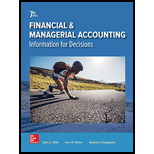
1.
To identify: The total amount of asset invested in A Company and in G Company..
1.
Explanation of Solution
(a)
For A Company
The total asset invested in A Company is $290,479
As per the
Thus, the total amount of asset is $290,479.
(b)
For G Company
The total asset invested in G Company is $147,461
As per the accounting equation the asset will always equal to the sum of liabilities and equity. This equation represents that the assets are enough to pay the dues and to the shareholders. So the amount of asset invested in a company is $147,461.
Thus, the total amount of asset is $147,461.
2.
To compute: Return on asset of A Company and G Company.
2.
Explanation of Solution
(a)
Given,
Net income is $53,394 million.
Assets in the beginning of the year is $231,839 million
Assets at the end of the year is $290,479 million
The formula to calculate return on asset is,
Substitute $53,394 million for net income, $231,839 million for assets in the beginning, $290,479 million for assets at the end.
Hence, the return on asset of A Company is 20.4%.
(b)
Given,
Net income is $16,348 million.
Assets in the beginning of the year is $129,187 million
Assets at the end of the year is $147,461 million
The formula to calculate return on asset is,
Substitute $16,384 million for net income, $129,187 million for assets in the beginning, $147,461 million for assets at the end.
Hence, the return on asset of G Company is 11.8%.
3.
To compute: The total expenses of A Company and G Company.
3.
Explanation of Solution
(a)
Given,
Net income is $53,394 million.
Revenue is $233,715 million
The formula to calculate expenses is,
Substitute $53,394 million for net income and $233,715 million for revenues.
Hence, the expenses of A Company are $180,321 million.
(b)
Given,
Net income is $16,348 million.
Revenue is $74,989 million.
The formula to calculate expenses is,
Substitute $16,348 million for net income and $74,989 million for revenues.
Hence, the expenses of G Company are $58,641 million.
4.
To compare: The return on asset of A Company and G Company with their competitors.
4.
Explanation of Solution
(a)
The return on assert of A Company is more than to its competitors.
As the A Company return on asset is 20.4%, which is more than 10% the return on asset of competitors.
Thus, the performance of A Company is satisfactory.
(b)
The return on assert of G Company is more than to its competitors.
As the A Company return on asset is 11.8%, which is more than 10% the return on asset of competitors.
Thus, the performance of G Company is satisfactory.
5.
To Analyze: Analyze the performance of A Company and G Company.
5.
Explanation of Solution
The return on assets of A Company is 20.4% which is better than the competitor and the return on asset of G Company.
The return of asset of G Company is 11.8% which is better than the competitor.
Thus, the performance of A Company is better than the G Company.
Want to see more full solutions like this?
Chapter 1 Solutions
Financial and Managerial Accounting
- What is the unrealized inventory profit to be deferred on Dec 31, 2016?arrow_forwardMarion Products Ltd manufactures a single product and follows a JIT policy where ending inventory must equal 20% of the next month's sales. It estimates that July’s ending inventory will consist of 40,000 units. August and September sales are estimated to be 250,000 and 265,000 units, respectively. Marion assigns variable overhead at a rate of $4.10 per unit of production. Fixed overhead equals $390,000 per month. Compute the number of units to be produced and the total budgeted overhead that would appear on the factory overhead budget for the month of August.arrow_forwardI am looking for the correct answer to this general accounting problem using valid accounting standards.arrow_forward
- Can you help me solve this general accounting question using the correct accounting procedures?arrow_forwardI need help solving this financial accounting question with the proper methodology.arrow_forwardCan you provide the valid approach to solving this financial accounting question with suitable standards?arrow_forward
- I need help finding the accurate solution to this general accounting problem with valid methods.arrow_forwardI need assistance with this general accounting question using appropriate principles.arrow_forwardCan you solve this general accounting problem using accurate calculation methods?arrow_forward

 AccountingAccountingISBN:9781337272094Author:WARREN, Carl S., Reeve, James M., Duchac, Jonathan E.Publisher:Cengage Learning,
AccountingAccountingISBN:9781337272094Author:WARREN, Carl S., Reeve, James M., Duchac, Jonathan E.Publisher:Cengage Learning, Accounting Information SystemsAccountingISBN:9781337619202Author:Hall, James A.Publisher:Cengage Learning,
Accounting Information SystemsAccountingISBN:9781337619202Author:Hall, James A.Publisher:Cengage Learning, Horngren's Cost Accounting: A Managerial Emphasis...AccountingISBN:9780134475585Author:Srikant M. Datar, Madhav V. RajanPublisher:PEARSON
Horngren's Cost Accounting: A Managerial Emphasis...AccountingISBN:9780134475585Author:Srikant M. Datar, Madhav V. RajanPublisher:PEARSON Intermediate AccountingAccountingISBN:9781259722660Author:J. David Spiceland, Mark W. Nelson, Wayne M ThomasPublisher:McGraw-Hill Education
Intermediate AccountingAccountingISBN:9781259722660Author:J. David Spiceland, Mark W. Nelson, Wayne M ThomasPublisher:McGraw-Hill Education Financial and Managerial AccountingAccountingISBN:9781259726705Author:John J Wild, Ken W. Shaw, Barbara Chiappetta Fundamental Accounting PrinciplesPublisher:McGraw-Hill Education
Financial and Managerial AccountingAccountingISBN:9781259726705Author:John J Wild, Ken W. Shaw, Barbara Chiappetta Fundamental Accounting PrinciplesPublisher:McGraw-Hill Education





